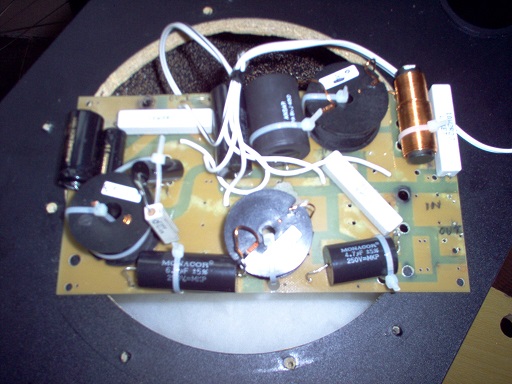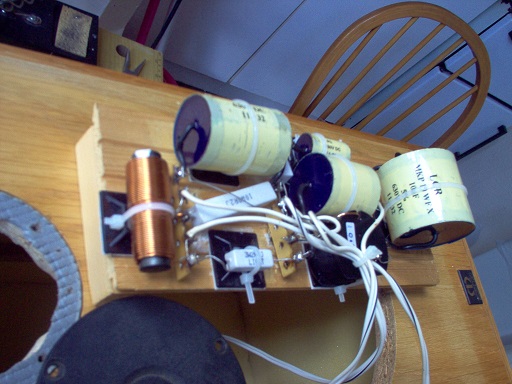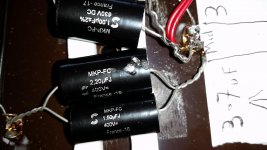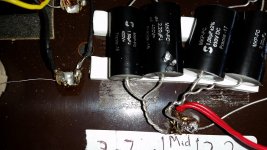Capacitor 101:

Polar Electrolytic capacitors are, IIRC, two layers of aluminium foil with a layer of blotting paper in between. The whole caboodle is then soaked in a jelly like conducting electrolyte of something or other. When a voltage is applied, the electrolyte reacts with the aluminium to form an oxide layer.
You now have a conductor, a microscopically thin layer of oxide which is the non-conducting dielectric, and the metal conductor foil. A high capacitance, because the dielectric is so thin.
I can't remember why it is highly polarised, and don't care. It certainly measures much higher resistance if you get polarity wrong and degrades rapidly, IIRC. You now place two back to back and it works either way. A Non-polarised.
Low loss is not a big trick. Parallel two and resistance is halved. Which is a bigger device. High voltage needs a thicker oxide layer I suppose. There must be some chemical trick to do this.
Film capacitors are very thin layers of metallised foil wound concentrically. You end up with foil with plastic dielectric inbetween. MKP if it is polypropylene foil. MKT if it is a polyester plastic. We used to use a copper core, polythene dielectric and an aluminium outer in telecom cables. Quality depends on the metals and the dielectric loss of the plastic dielectric.
I think Dissipation Factor DF is the tangent or inverse tangent of the phase angle at a particular frequency. 5% might be 1/20 of 2Pi radians or about 15 degrees. Which corresponds to resistive loss around 0.5 or 1 ohm. TBH, I have forgotten. MKP has a DF of about 0.1%.
The fact is MKP is about the least lossy type. It works like it says on the side. There are some measurements that says really cheap foils are relatively more resistive at low frequency, and thicker ones might work better.

My Professor at college said such tolerances only affect the circuit at the 3db crossover point, which is where phase angle between current and voltage is most extreme and the capacitor most stressed. Above that, the capacitor is a dead short and might as well not be there.
Well, that's what I know.
I am more intrigued by soldering irons for £1 at poundland. Any good? Picture please. 😀
Handy soldering tip #4: Always G-Clamp your iron holder to a work surface. Otherwise, if you knock it over you tend to burn something. Usually you. 😱
Polar Electrolytic capacitors are, IIRC, two layers of aluminium foil with a layer of blotting paper in between. The whole caboodle is then soaked in a jelly like conducting electrolyte of something or other. When a voltage is applied, the electrolyte reacts with the aluminium to form an oxide layer.
You now have a conductor, a microscopically thin layer of oxide which is the non-conducting dielectric, and the metal conductor foil. A high capacitance, because the dielectric is so thin.
I can't remember why it is highly polarised, and don't care. It certainly measures much higher resistance if you get polarity wrong and degrades rapidly, IIRC. You now place two back to back and it works either way. A Non-polarised.
Low loss is not a big trick. Parallel two and resistance is halved. Which is a bigger device. High voltage needs a thicker oxide layer I suppose. There must be some chemical trick to do this.
Film capacitors are very thin layers of metallised foil wound concentrically. You end up with foil with plastic dielectric inbetween. MKP if it is polypropylene foil. MKT if it is a polyester plastic. We used to use a copper core, polythene dielectric and an aluminium outer in telecom cables. Quality depends on the metals and the dielectric loss of the plastic dielectric.
I think Dissipation Factor DF is the tangent or inverse tangent of the phase angle at a particular frequency. 5% might be 1/20 of 2Pi radians or about 15 degrees. Which corresponds to resistive loss around 0.5 or 1 ohm. TBH, I have forgotten. MKP has a DF of about 0.1%.
The fact is MKP is about the least lossy type. It works like it says on the side. There are some measurements that says really cheap foils are relatively more resistive at low frequency, and thicker ones might work better.
My Professor at college said such tolerances only affect the circuit at the 3db crossover point, which is where phase angle between current and voltage is most extreme and the capacitor most stressed. Above that, the capacitor is a dead short and might as well not be there.
Well, that's what I know.
I am more intrigued by soldering irons for £1 at poundland. Any good? Picture please. 😀
Handy soldering tip #4: Always G-Clamp your iron holder to a work surface. Otherwise, if you knock it over you tend to burn something. Usually you. 😱
Last edited:
I can't remember why it is highly polarised, and don't care. It certainly measures much higher resistance if you get polarity wrong and degrades rapidly.
Thanks for that comprehensive description of the types of capacitors and their properties.
Although I suspect that the layman is content to imagine the capacitor as a 'magic black box'!
OK so you don't care, however for completeness I feel compelled to add . . .
Reversing the polarity of the dc voltage applied to a polar electrolytic reverses the electrochemical reaction which formed the capacitor in the first place.
The thin aluminium oxide dielectric layer is destroyed and hot gases are evolved. The resulting internal pressure can make the capacitor bulge and, in extreme cases, explode!
Large, high voltage electrolytics are fitted with a safety valve to allow the gases to vent safely in the event of reverse connection.
Moral - Avoid connecting polar electrolytics to a dc supply the wrong way round!
Do I have to bin this one and re order another?
No, that's just some surface damage which won't affect the operation of the capacitor.
Thanks Galu ... stupid me ... It seems to have broken the surface insulator and exposed / slightly damaged the silvery layer beneath ...No, that's just some surface damage which won't affect the operation of the capacitor.
That's not worth worrying about.
I'm more concerned about the integrity of the solder joint of which the red wires are a part.
It looks scrappy and I don't like seeing the bare copper wire.
I would re-heat the joint and flow on more solder. But be careful not to overheat!
I'm more concerned about the integrity of the solder joint of which the red wires are a part.
It looks scrappy and I don't like seeing the bare copper wire.
I would re-heat the joint and flow on more solder. But be careful not to overheat!
I've done my best to stay away from disturbing as many joints as I can .... I've had a closer look at the joint in question . ( which I've not touched ) and it looks like its flux on solder and not copper that is making the orange colour ..That's not worth worrying about.
I'm more concerned about the integrity of the solder joint of which the red wires are a part.
It looks scrappy and I don't like seeing the bare copper wire.
I would re-heat the joint and flow on more solder. But be careful not to overheat!
Well I've just plugged them in ...
My first reaction is ..... I don't think I've made them worse 🙂
I'll let you what I think in a week or so 🙂
Time for a beer .
A really big big thanks for every ones help 🙂
Dom
My first reaction is ..... I don't think I've made them worse 🙂
I'll let you what I think in a week or so 🙂
Time for a beer .
A really big big thanks for every ones help 🙂
Dom
Well I've just plugged them in ...
My first reaction is ..... I don't think I've made them worse 🙂
I'll let you what I think in a week or so 🙂
Time for a beer .
A really big big thanks for every ones help 🙂
Dom
Most excellent. Well done. FWIW, your cheapie soldering iron should really have had a stand with bit of wet sponge for cleaning it in use. But that can be improvised. I expect you can buy replacement tips at a place like screwfix.
You are right. It takes a while to get used to a speaker modification. Enjoy your beer. 🙂
I don't think I've made them worse 🙂
Dom
Well, at least you can now be confident that the 25s are performing to the best of their ability - and you've learned some things along the way!
You've earned that beer, so enjoy!
Glad to have been of help.
wet sponge
Wet sponge! What about thermal shock?
Isn't brass cleaning wool preferable?
(We could stretch this thread out a bit further could we not?!) 😀
""(We could stretch this thread out a bit further could we not?!) 😀""
Ahh mate ... I've got dreams of owning a pair of 66's
this threads got years in it yet lol
After the 1st hour of listening ... Deffo an inprovement ... ..
Ahh mate ... I've got dreams of owning a pair of 66's
this threads got years in it yet lol
After the 1st hour of listening ... Deffo an inprovement ... ..
Hi there ... Well .. I said it would take me a week to listen to them .... well life got in the way ,and 6 weeks later I have just swapped back to my old un touched pair ...
I'm now gonna listen to them for a week or so ...
The new caps and fixing the internal bracing of the cab, have really sweetened up the sound. .Pretty much across the whole spectrum ..tightening up the base and clearing the treble ... And I would recommend it to any one with speakers this old.
After playing just 2 songs .. on the un mod 25's I can literaly see!!! and hear the response is lacking some definition in the bass that the recapped ones now have 🙂 ..
Thanks every one .. And sorry it took so long to give the revue
.
I'm now gonna listen to them for a week or so ...
The new caps and fixing the internal bracing of the cab, have really sweetened up the sound. .Pretty much across the whole spectrum ..tightening up the base and clearing the treble ... And I would recommend it to any one with speakers this old.
After playing just 2 songs .. on the un mod 25's I can literaly see!!! and hear the response is lacking some definition in the bass that the recapped ones now have 🙂 ..
Thanks every one .. And sorry it took so long to give the revue
.
Wow! That was six weeks ago? How time flies!Thanks every one .. And sorry it took so long to give the revue.
Thanks for your feedback. Glad to have been of some help. 🙂
Wow! That was six weeks ago? How time flies!
Thanks for your feedback. Glad to have been of some help. 🙂
I am really pleased with the results ... which is one reason why it took 6 weeks before I could bring myself to unplug them 🙂
After listening to the old pair for a week .. the difference is really noticable
I am in no doubt the recapped pair are far superior 🙂
And I have changed back today .. And will deffo proceed with the recapping of the old pair .. I hope they come up as good coz I prefer the old cabinets 🙂
And also I have a pair of 50+ year old 10 inch RED dual concentric Tannoy Cadets to work on ... these I have really high hopes for 🙂
SUMMARY
VERY VERY HAPPY WITH THE RESULTS 🙂
I am in no doubt the recapped pair are far superior 🙂
And I have changed back today .. And will deffo proceed with the recapping of the old pair .. I hope they come up as good coz I prefer the old cabinets 🙂
And also I have a pair of 50+ year old 10 inch RED dual concentric Tannoy Cadets to work on ... these I have really high hopes for 🙂
SUMMARY
VERY VERY HAPPY WITH THE RESULTS 🙂
Would you be willing to do the crossovers first, so that you can compare braced/unbraced with identical crossovers, then let us know?
I have a pair of 15s that need a little love, if I don't play them for six months a cap in one takes twenty minutes to reform and let the highs through. So I'm curious about the bracing.
I'm glad you're enjoying them, there's something about snares and traps on a Ditton.
I have a pair of 15s that need a little love, if I don't play them for six months a cap in one takes twenty minutes to reform and let the highs through. So I'm curious about the bracing.
I'm glad you're enjoying them, there's something about snares and traps on a Ditton.
Sorry very unlikely ..Would you be willing to do the crossovers first, so that you can compare braced/unbraced with identical crossovers, then let us know?
I have a pair of 15s that need a little love, if I don't play them for six months a cap in one takes twenty minutes to reform and let the highs through. So I'm curious about the bracing.
I'm glad you're enjoying them, there's something about snares and traps on a Ditton.
- Status
- Not open for further replies.
- Home
- Loudspeakers
- Multi-Way
- Celestion Ditton 25 help needed



